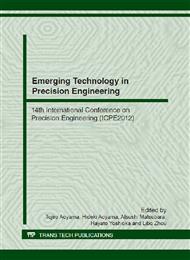p.226
p.232
p.238
p.244
p.250
p.256
p.262
p.267
p.272
A Study on Driven-Type Rotary Cutting for Finish Turning of Carburized Hardened Steel
Abstract:
Recently, cutting has replaced grinding in the finish processing of hardened steel. However, tool damage is a major problem in high-efficiency operations that use high-speed cutting and high feed rate conditions instead of the present cutting conditions. Therefore, the examination of a new cutting technique that can realize high-efficiency cutting is desired. In this study, the effects and efficiency of driven rotary cutting are investigated in the finish turning of carburized hardened steel. Based on the results, flaking occurs at the cutting edge at a short cutting length of 0.2 km using single-point turning. On the other hand, even if the cutting length amounts to 1.5 km, the tool wear width without flaking is small in the case of a driven rotary tool. Additionally, the tool wear is uniformly distributed along the circumference of the cutting edge. Furthermore, based on an examination of high-efficiency processing by increasing the feed rate, it is clarified that a feed rate of 0.3 mm/rev is the optimum condition from the viewpoint of wear resistance and surface roughness. Additionally, even if the cutting length amounts to 5.0 km for this condition, the flank wear width is as small as 0.04 mm, and the tool wear progresses gradually.
Info:
Periodical:
Pages:
250-255
Citation:
Online since:
November 2012
Price:
Сopyright:
© 2012 Trans Tech Publications Ltd. All Rights Reserved
Share:
Citation:


